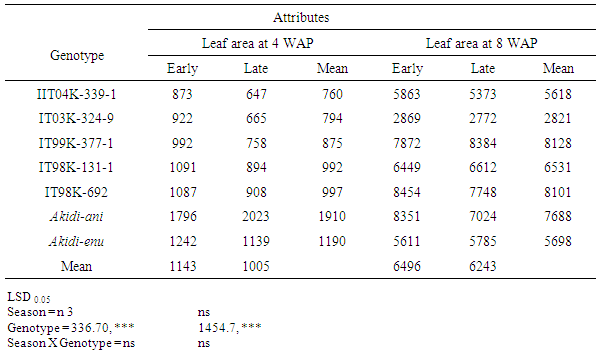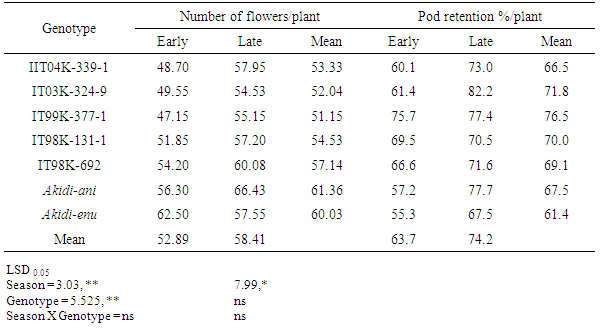-
Paper Information
- Paper Submission
-
Journal Information
- About This Journal
- Editorial Board
- Current Issue
- Archive
- Author Guidelines
- Contact Us
International Journal of Agriculture and Forestry
p-ISSN: 2165-882X e-ISSN: 2165-8846
2015; 5(3): 205-210
doi:10.5923/j.ijaf.20150503.05
Growth and Yield of Some Vegetable Cowpea Genotypes as Influenced by Planting Season
Nwofia G. E.1, Ogbonna N. D.1, Agbo C. U.2, Mbah E. U.1
1Department of Agronomy, Michael Okpara University of Agriculture, Umudike, Nigeria
2Department of Crop Science, University of Nigeria, Nsukka, Nigeria
Correspondence to: Nwofia G. E., Department of Agronomy, Michael Okpara University of Agriculture, Umudike, Nigeria.
| Email: |  |
Copyright © 2015 Scientific & Academic Publishing. All Rights Reserved.
Seven promising vegetable cowpea (Vigna unguiculata(L.) Walp)genotypes were evaluated at Michael Okpara University of Agriculture, Umudike, Nigeria (05°29´N, 07°33´E, 122 masl) in 2011 early and late cropping seasons using split plot in randomized complete block design with four replications. Planting season constituted the main plot while vegetable cowpea genotypes were assigned into the sub-plots. The objectives of the study was to evaluate the growth, yield and yield components of seven vegetables cowpea genotypes as influenced by planting seasons in the humid tropics of south eastern Nigeria. The results revealed that planting season significantly (P<0.01) influenced growth and yield parameters. Early season planting encouraged vegetative growth of cowpea such as number of branches per plant and plant height contrary to late season planting which induced higher dry matter yield, number of flowers per plant, pod retention percent per plant, number of fresh pod per sq. meter, number of seeds per plant and pod yield (kg/ha). On the average across the both planting seasons (early and late), pod yield of cowpea genotypes was significantly (P<0.01) depressed in this sequential order –IIT04K-339-1>IT98K-131-1>Akidi-ani>IT03K-324-9>Akidi-enu>IT98K-692>IT99K-377-1. Among the cowpea genotypes evaluated in the study, IT99K-377-1, IT98K-692 and Akidi-enu gave significant pod yields that were higher by 30.46%, 28.86% and 22.38%, respectively compared to the lowest pod yielding genotype (IIT04K-339-1). These promising high yielding genotypes can be evaluated on-farm for farmers’ benefits as well as to enhance food security and improve the protein intake of people living in sub-Sahara Africa.
Keywords: Vegetable cowpea, Genotype, Planting season, Growth, Yield
Cite this paper: Nwofia G. E., Ogbonna N. D., Agbo C. U., Mbah E. U., Growth and Yield of Some Vegetable Cowpea Genotypes as Influenced by Planting Season, International Journal of Agriculture and Forestry, Vol. 5 No. 3, 2015, pp. 205-210. doi: 10.5923/j.ijaf.20150503.05.
1. Introduction
- Cowpea is a food legume that plays a critical role in the lives of millions of people in Africa and other parts of the developing world. Both the grain and the haulm, which serves to improve the nutrient level of the crop, are valuable dietary proteins for the African human population and their livestock (Fatokun, 2002). The grain contains between 20 - 25 per cent of protein, about twice the protein content of most cereals (Kay, 1979). The crop is also a valuable and dependable commodity that produces income for many small holder farmers and traders in sub-Saharan Africa (Langyintuo, 2003). Cowpea is a deep rooted crop and does well in sandy soils and more tolerant to drought than soybean (Dabsun et al., 2003). The crop cowpea is a major component of the tropical cropping system because of its ability to improve marginal lands through nitrogen fixation and as a cover crop (Sanginga et al., 2003; Abayomi, 2008). The crop can fix about 240 kg/ha of atmospheric nitrogen and make available 60 – 70 kg/ha nitrogen for succeeding crops grown in rotation with it (Amira, and Oduwaye, 2007).In Nigeria, cowpea is one of the most cultivated legumes, however until recently, its cultivation was restricted to the Sahel, guinea and derived savanna regions. In the humid forest fringes, the most widely grown varieties are the vegetable types whose immature pods are eaten by humans. The indigenous varieties are climbing and decumbent in character but recently, erect and bushy varieties have been developed at International Institute of Tropical Agriculture (IITA), Ibadan, Nigeria (Mittal et al., 1980 and Umaharan et al., 1997) with the objective of increasing yield. In the production of vegetable cowpea, the green pod which is expressed in kg/ha or t/ha serves as the yield while some researchers have argued that the yield should be expressed as the number of marketable pods/ha, because the pods are usually marketed in bundles (Brathwaite, 1982). Farmers in South eastern, Nigeria usually plant vegetable cowpea in the rainy season periods of April – July and this contributes substantially to the dietary protein of the rural poor during one half of the year (Okpara and Oshilim, 2001) though the seeds can also be relied upon during the lean period (Uguru, 1996). Due to the importance of this vegetable legume in the dietary needs of the rural poor whose diets have been shown to be deficient of protein of high biological value (Latham, 2006), there is a need to have the fresh pods all year round. Hence, the objective of this study was to evaluate the growth, yield and yield components of seven genotypes of vegetable cowpea as influenced by planting seasons in the south eastern agro-ecological region of Nigeria.
2. Materials and Methods
- Two field experiments were conducted in March (early planting) and September (late planting), 2011. Both experiments were carried out in the Research farm of Michael Okpara University of Agriculture, Umudike (05°29´N, 33 E, 122 masl). The weather data of the experimental site are shown in Table 2. The seven vegetable cowpea genotypes used in this study were obtained from the International Institute of Tropical, Agriculture (IITA), Ibadan and farmers at Nsukka, Enugu State, Nigeria and they are IT04k-339-1, IT98k-692, IT03k-324-9, IT98k-131-2, IT 99k-377-1, Akidi-ani and Akidi-enu. The experiment was laid out as a split-plot in a randomized complete block design (RCBD) replicated four times with planting season as the main plot and the vegetable cowpea genotypes as the sub-plot. The sub-plot size was 3 x 3 m. Two seeds each of the vegetable cowpea genotypes were hand sown two per hole on 22nd March and 15th September, 2011 at a spacing of 30 cm within row and 50 cm between rows. The seedlings were thinned to one plant per stand at two weeks after planting (WAP) to give a plant population of 133,333 plants per ha. All experimental plots were weeded at 4 and 8 WAP with hand hoe while insect pests were controlled with Cypermethrin 10 EC at 2.5 ml per litre of water using a knapsack sprayer at 2 weekly intervals from 21 days after planting (DAP). No fertilizer was applied in keeping with the farmers’ practice in this -ecological region of Nigeria. Growth and yield data such as plant height (cm), number of branches per plant, number of flowers per plant, dry matter (g), number of pods per plant, pod length (cm), pod width (cm), pod weight (g), Pod retention percentage per plant (%), number of pods per m-2, number of seeds per plant, 100-seed weight (g) and fresh pod yield (kg/ha) were measured and recorded.Data were processed by analysis of variances procedures using Genstat Discovery Edition 3 (Genstat, 2007) and treatment means separated by using the least significant difference as outlined by Obi (2002).
3. Results and Discussion
- Planting season showed highly significant (P<0.01) difference for number of branches per plant at 4 and 8 weeks after planting (WAP) (Table 1). Early planting induced more branches per plant at the sampling dates than late planting. High significant (P<0.01) genotypic effect was observed among the cowpea genotypes for number of branches per plant and plant height at 4 and 8 WAP. The results corroborates the findings of Kelechukwu et al. (2007) who reported that cowpea height is dependent on the type of variety as certain varieties are genetically taller than others. The mean of the two seasons showed that Akidi-enu had the lowest number of branches per plant at the sampling dates contrary to Akidi-ani, a prostrate local cultivar. Akidi-ani had more branches per plant at 4 WAP, an indication that the peak of rains in early season planting encouraged vegetable cowpea branching, especially in the prostrate cultivar. The findings are in consonance with previous reports by Nanju (1979) on the effect of density, plant type and season on cowpea growth and yield. Further more, Ali et al. (2009) and Ichi et al. (2013) in their respective studies on cowpea observed that significant difference in number of branches per plant could be as a result of difference in cowpea varieties. The interaction between planting season and genotypes was not significant for the characters evaluated.
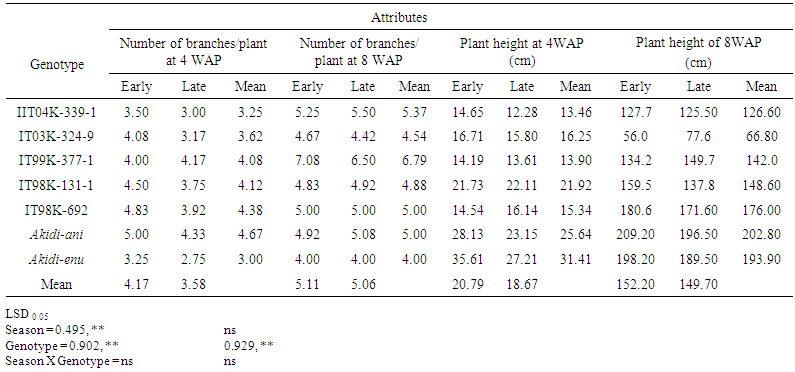 | Table 1. Number of branches/plant and plant height (cm) at 4 and 8 WAP of seven genotypes of vegetable cowpea as influenced by planting season |
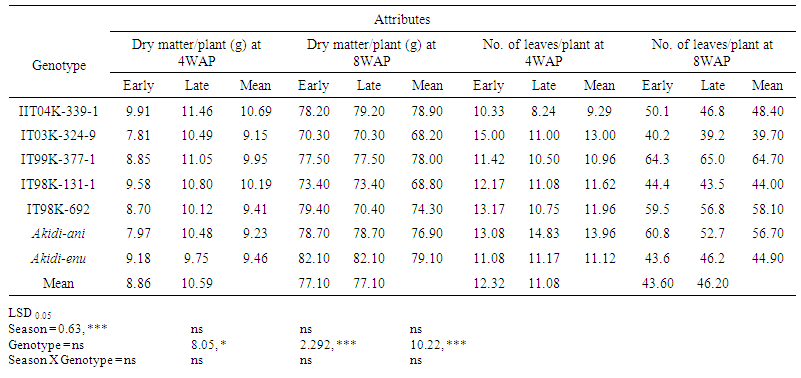 | Table 2. Dry matter/plants and number of leaves/plant of 4 and 8 weeks after planting of seven genotypes of vegetable cowpea as influenced by planting season |
|
|
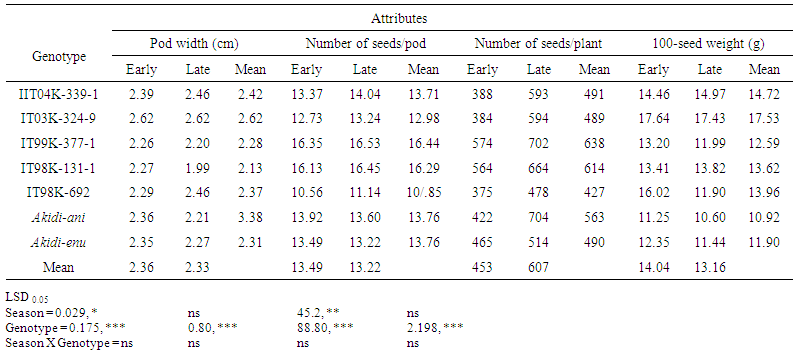 | Table 5. Pod width (cm), number of seeds/pod, number of seeds/plant, 100- seed weight (g) of seven genotypes of vegetable cowpea as influenced by planting season |
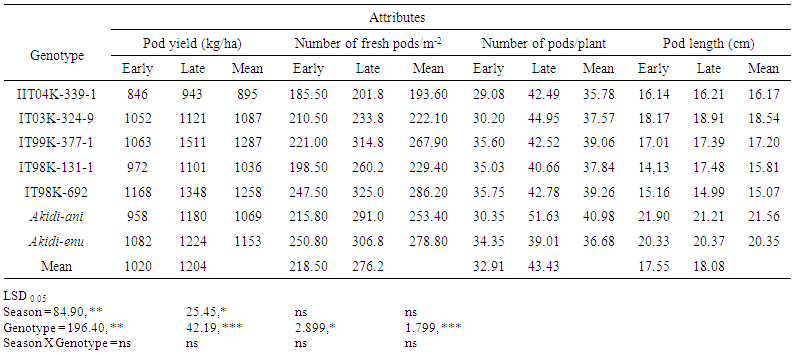 | Table 6. Fresh pod yield (kg/ha), number of fresh pods/m-2, number of pods/plant, pod length (cm) of seven genotypes of vegetable cowpea as influenced by planting season |
4. Conclusions
- The studies revealed that late season planting of cowpea significantly enhanced the growth and yield of the crop than early season planting. IT99K-377-1, IT98K-692 and Akidi-enu cowpea genotypes were found to be very promising (high yielding), across the two seasons, hence can be encouraged to be evaluated on-farm as farmer managed research studies to deepen the findings for farmers’ benefit as well as enhance food security in sub-Sahara Africa in terms of increasing the protein content in the diet of the people.
 Abstract
Abstract Reference
Reference Full-Text PDF
Full-Text PDF Full-text HTML
Full-text HTML